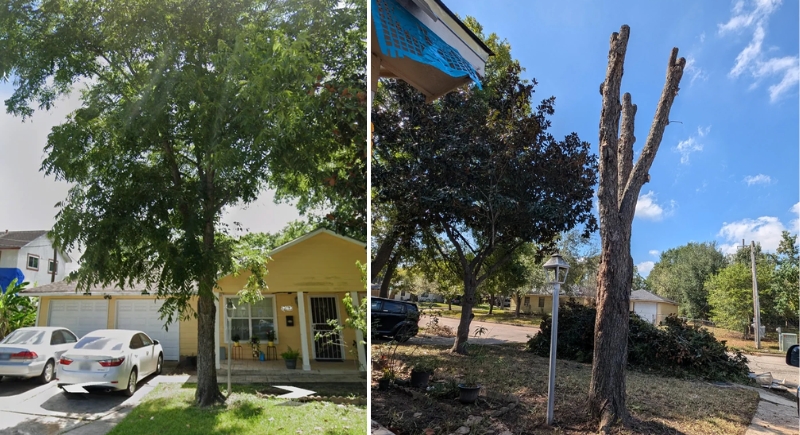This Landlord Sent Someone to ‘Trim’ a Pecan Tree and They Accidentally Cut It All Down
When a Reddit user noticed a landscaping crew show up without warning, they assumed the team was there for a simple yard cleanup. Instead, the workers took down an entire pecan tree that had long shaded the property. The landlord had only requested a “trim,” but what was meant to be routine maintenance ended in complete removal, leaving nothing but a stump and a sunbaked patch of ground where the tree once stood.
The Tenant Valued the Tree Despite Minor Inconveniences

Image via Getty Images/tbm massage
The pecan tree wasn’t causing any property damage, nor was it interfering with the driveway or threatening the house foundation. Its only offense was one low branch that sometimes hit the tenant in the head. Still, the tree had long been appreciated for its shade, especially for the tenant’s truck, which benefited from its full canopy throughout the year. The pecans it dropped were unripe and constant, but that was seen as a fair trade for having natural cover during months of hot weather.
At the time the professionals arrived, the temperature hovered around 90°F, which made the loss of shade even more noticeable. The tenant hadn’t requested any major work to be done on the tree. Instead, they had been planning to bring in a professional team, including their mother’s landscaping workers, to address the yard’s issues more broadly and carefully, including minor tree trimming where needed.
The Landlord Disregarded the Tenant’s Plans
Despite the tenant’s plans to improve the yard with help from experienced landscapers, the landlord moved forward independently. She arranged for someone to address what she viewed as a problem with curb appeal. According to the tenant, the landlord had a long-standing dislike for the tree, even though it had been planted by her late husband.
Soil in the yard had lost its nutrients, rainfall had been low for the season, and attempts to grow grass had failed. The tenant had explained this and proposed a solution just the week before. The landlord ignored that offer and sent an unknown team to the property. That crew didn’t communicate with the tenant or follow any specific pruning strategy. They stripped the tree down to its base and left behind no branches or shade. The damage wasn’t limited to appearance. Rather, it also affected the utility of the space and made the yard even more difficult to manage in the heat.
Improper Techniques Caused Long-Term Harm

Image via Reddit/Mexican_Texican
The method used on the pecan tree resembled topping rather than trimming or pruning. Arborists who saw the photo on Reddit immediately recognized the issue. Topping removes the upper structure of a tree, often cutting through large limbs and leaving stubs. It is not a recommended practice and can shorten a tree’s lifespan significantly.
One certified arborist commented that this was not pollarding, a term some tried to apply. Pollarding is a specialized method that removes upper branches while preserving the tree’s health and form, but only some species tolerate it. Even in those cases, pollarding must be done with precision. Pecan trees are not good candidates for such severe techniques.
They recover poorly and may not survive aggressive cuts. Cutting a pecan tree down to the trunk, as in this case, opens it to disease and decay. If the tree does survive, it may grow back in a way that is harder to control and less structurally sound.